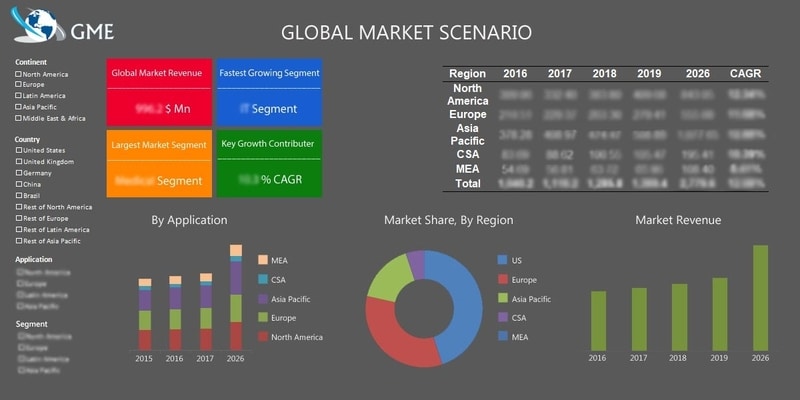
Global Household Slicer Market Size, Trends, and Analysis with COVID-19 Impact - Forecasts 2026 By Product (Automatic, Manual), By Distribution Channel (Offline, Online), By Region (North America, Europe, Asia Pacific and Rest of the World); and Company Market Share Analysis & Competitor Analysis
Household Slicer Market Insights
The global household slicer market will propel at a high rate during the forecast period from 2020 to 2026. The household slicer is made up of a steel frame and textured cast aluminum. The blade is tempered steel which is easy to clean due to a proprietary device that allows it to be quickly disassembled. Home-based food slicers are becoming more common as they reduce the time taken compared to conventional equipment to cut different types of foods. Hence, the growing demand for specialized equipment and the development of modern cuisines are increasing trend for a household slicer. The increasing preference for effective residential kitchen tool pumps up demand for household slicers. However, the fluctuation in prices of slicers and concerns associated with product safety are some of the factors likely to hinder demand development in the coming years.
Household Slicer Market: By Product
Based on the product, the global household slicer market is segmented into manual, and automatic. Amongst all the types of products, the manual type of product will be the fastest-growing segment and also the largest market shareholder in terms of revenue over the coming years. This is attributed to the rising availability of products at a wide variety of prices, which is one of the main drivers boosting the demand in the coming years. The increasing interest in cooking shows, especially among the younger population is driving the segment growth.
Household Slicer Market: By Distribution Channel
Based on the study of the distribution channel, this market is bifurcated into two segments namely; offline, and online. The largest share contributed in terms of revenue to this segment of the market is the offline segment. The increased popularity of retail networks as they make it possible for customers to look at the products first-hand, which enables them to accurately check the standard and specifications, is expected to fuel the growth of the distribution channel. Furthermore, the rising focus on customer needs and the availability of products offered by various brands are the factors expected to propel the market growth over the coming years from 2020-2026.

Household Slicer Market: By Region
Given by the region, the global household slicer market is bifurcated into Europe, North America, Asia-Pacific, Middle East & Africa, and CSA. North America region will have the largest market penetration in the global household slicer market. The increasing development of new products and innovations in slicers is driving the growth of the market of the household slicer. Moreover, the growing demand for slicers in sleek, comfortable, and stylish slicers is expected to propel the market growth in the region. Furthermore, the Asia-Pacific region is projected to be the fastest-growing region during the forecast period due to the growing awareness among consumers to invest in high-quality conventional appliances with modern cuisines in countries such as India, Japan, and China. The increasing investments in the residential sector are also expected to propel the market growth in the APAC region.
Household Slicer Market Share & Competitor Analysis
The key players operating in this market are Magurit Gefrierschneider GmbH, MHS Schneidetechnik, Foodmate, Bizerba SE & Co. KG, Hallde, Bizerba SE & Co. KG, Swedinghaus, Devile Technologies, Brunner GmbH, and Wente-Thiedig GmbH among others.
Please note: This is not an exhaustive list of companies profiled in the report.
Check the Press Release on Global Household Slicer Market Report
Household Slicer Market: By Product
Household Slicer Market: By Distribution Channel
Household Slicer Market: By Region
The global Household Slicer Market has been studied from the year 2017 till 2026. However, the CAGR provided in the report is from the year 2018 to 2026. The research methodology involved three stages: Desk research, Primary research, and Analysis & Output from the entire research process.

The desk research involved a robust background study which meant referring to paid and unpaid databases to understand the market dynamics; mapping contracts from press releases; identifying the key players in the market, studying their product portfolio, competition level, annual reports/SEC filings & investor presentations; and learning the demand and supply side analysis for the Household Slicer Market.

The primary research activity included telephonic conversations with more than 50 tier 1 industry consultants, distributors, and end-use product manufacturers.

Finally, based on the above thorough research process, an in-depth analysis was carried out considering the following aspects: market attractiveness, current & future market trends, market share analysis, SWOT analysis of the companies and customer analytics.

Tailor made solutions just for you
80% of our clients seek made-to-order reports. How do you want us to tailor yours?
OUR CLIENTS